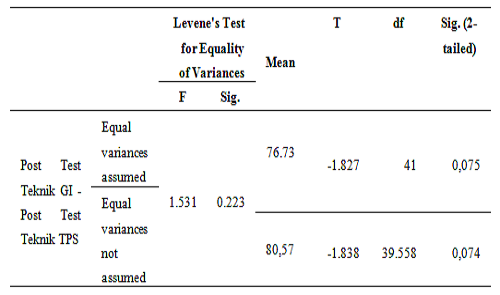
The Effectiveness of Collaborative Learning Throughtechniques on Group Investigation and Think Pair Share Students' Critical Thinking Ability on Chemical Equilibrium Material
Abstract
The purpose of this study was to determine the differences in the improvement of students' thinking skills using collaborative learning techniques Think-Pair-Share and Group Investigation. The research used was a quasi-experimental research design with non equivalent control posttest design. The data collection technique used critical thinking skills questions consisting of 5 essay test questions. Based on the research results of hypothesis testing using paired simple t-test , the results obtained were sig (2-tailed) <0.05, which means that collaborative learning of GI and TPS techniques is effective on critical thinking skills than the control class. Hypothesis testing is to see significant differences between collaborative learning. TPS and GI techniques used independent sample t-test and the results obtained were sig (2-tailed) <0.05, which means that there is a significant difference between collaborative learning of GI and TPS techniques on critical thinking skills. For the average percentage of critical thinking skills in the collaborative learning class, the Think-Pair-Share technique is 80.57% and Group Investigation is 76.73%, and in the control class it is 68.45%, which means the application of collaborative learning techniques Think-Pair- Share is more effectively used in improving students' critical thinking skills on chemical equilibrium material.
Keywords
Full Text:
PDFReferences
Azlina, N. A., Nik. (2010). CETs: Supporting Collaborative Activities Among Students and Teachers Through The Use Of Think-Pair-Share Techniques. IJCSI International Journal of Computer Science Issues, 5 (7), 18-29
Abdul, M. (2014). Implementation of 2013 Curriculum Theoretical and Practical Studies. Bandung: Interes Media
Arianti, R. (2020). Improvement of News Text Writing Skills Through Think Pair Share Model in VIII Grade Students of SMP Negeri 7 Rambah Samo. Journal of Educational Sciences, 4 (3), 607-619
Asyari, M. (2016). Improving Critical Thinking Skills Through The Integration Of Problem Based Learning And Group Investigation. State University Of Malang, Indonesia, 5 (1), 36.44.
Barkley, E. (2014). Collaborative Learning Techniques, Collaborative Learning Techniques. Bandung: Nusamedia.
Budiastra, S., & Arcana. (2015). The Effect of Cooperative Model Type GI (Group Investigation) on Critical Thinking Skills in Science Learning. E Journal of PGSD Ganesha University of Education, 1 (3).
Fischer, A. (2009). Critical Thinking An Introduction. Jakarta: Erlangga.
Kaddoura, M. (2013). Think Pair Share: A Teaching Learning Strategy to Enchance Student's Critical Thinking. Journal of Educational Research Quarterly. 36 (4), 3-24. Liliasari. (2003). Improving the Quality of Teachers in Higher Level Thinking Skills through the Capita Selecta Learning Model of Advanced School Chemistry. Journal of Mathematics and Science Education, 3 (8), 175.
Malmir, A. (2012). An Investigation Of The Impact Of Teaching Critical Thinking On The Iranian EFL Learners' Speaking Skill ". Journal of Language Teaching and Research, 3 (4), 608-617.
Regulation of the Minister of National Education of the Republic of Indonesia Number 23 of 2006 regarding Competency Standards for Graduates http://www.pbs.psma.org/files/2.SKL.pdf. 350.
Puspita, I., Sugiyarto, KH, & Ikhsan, J. (2016). Collaboration Of Chemistry Instructional Games And Group Investigation (GI) Model To Improve Learning Outcome In High School Students. Department Of Chemistry Education, Graduate School Of Yogyakarta State University. Proccedings Of The International Conference On Education, Mathematics And Science. DOI. 10.1063 / 1.4983906.
Rusyna, A. (2014). Thinking Skills Practical Guidelines for Researchers Thinking Skills. Yogyakarta: Waves
Salamah, U., Mardiyana., & Saputro, D. (2016). Group Investigation Experimentation and Think Pair Share with Assessment For Learning Through Peer-Assessment on Relationships and Functions in terms of Student Confidence, Journal of FKIP Sebelas Maret University Surakarta . ISBN 978-602-6122-20-9, 26.
Sugiono. (2017). Qualitative Approach Research Methods, Quantitative. Bandung: Alfabeta.
Surayya, L., Subagia, I W., & Tika, I N. (2014). The Effect of the Think Pair Share Learning Model on Science Learning Outcomes in terms of Students' Critical Thinking Skills. Science Education Study Program, Graduate Program, Ganesha University of Education.
Tamara, T. (2018). The Effect of the Application of the Think-Pair-Share Method and Group Investigation on Students' Critical Thinking Ability. Indonesian Journal of Economic Education, 1(1),73-84.
Tint, S S., & Nyunt, E E. (2015). Collaborative Learning With Think Pair Share Technique. An Internatinal Journal. 2(1), 4.
Zubaidah, S. (2010). Collaborative Learning And Group Investigation (As One Of The Collaborative Learning Techniques). Researchgate. FMIPA State University of Malang. 4.
DOI: http://dx.doi.org/10.31258/jes.5.1.p.198-208
Refbacks
- There are currently no refbacks.
Copyright (c) 2021 Fajrina Fauzi, Maria Erna, Roza Linda

This work is licensed under a Creative Commons Attribution 4.0 International License.
Publisher: FKIP Universitas Riau












